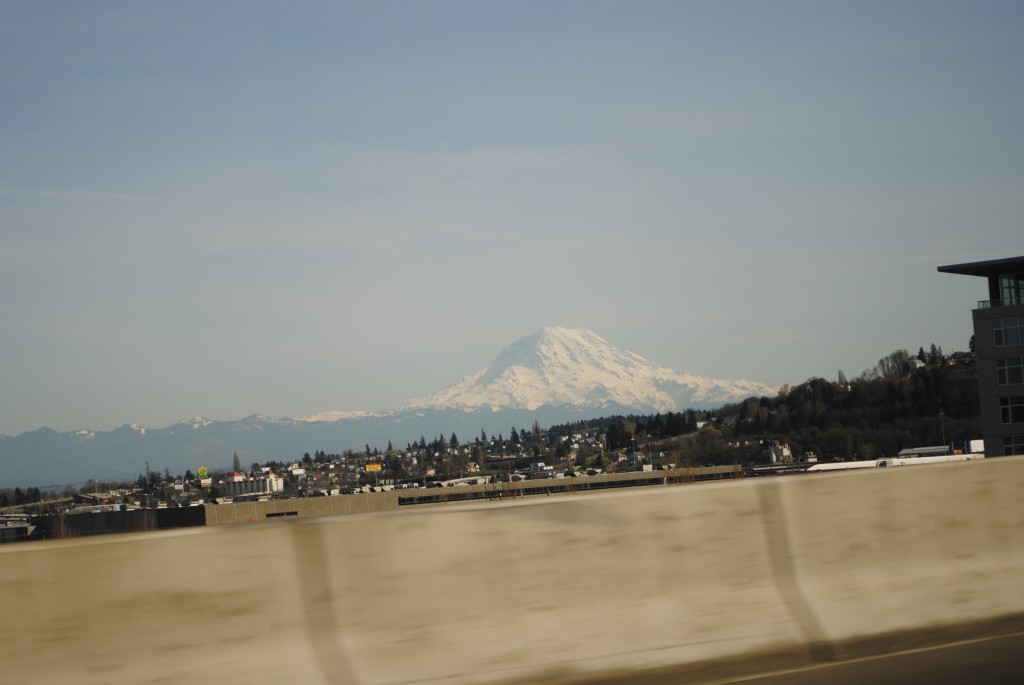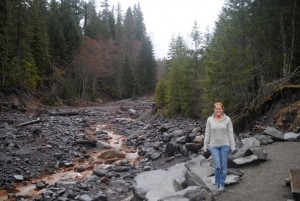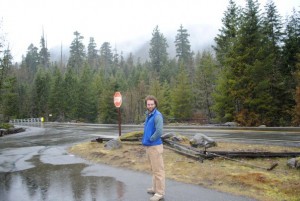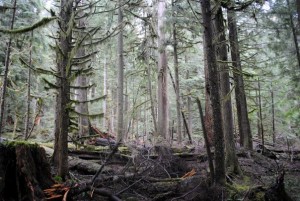Clocks are changing, sun is shining, snow is melting, and Francisco is cranking. Spring has officially sprung.
Last week, one of the head guides from the NOC sent out the annual “who’s coming back this year?” e-mail. A righteous landslide that buried road and river has pushed back the start of the season, but Ocoee guides will have been styling the Middle section for a few weekends by the time I leave Montana. That means that the clock is ticking on my summer-plan deliberation. I informed the managers there that I had to check out another option before I could commit, and Michelle and I summarily headed west toward Washington and the alpine big leagues of Mt. Rainier.

Mt. Rainier, as seen from Tacoma.
I’ve been interested in guiding big mountain trips for a while. I love working on the river, but I’m not really a boater (to be honest, kayaking scares me a lot; I’m not sure I can explain why I have such trouble rolling a kayak in class III whitewater and very little running it out forty feet on an ice lead, but, in the immortal words of Joe Dirt, “that’s what’s goin’ on”). Climbing is and will remain my foremost love, and I think I’ll be better and, ultimately, more satisfied as a climbing guide than as a river guide. With that goal in mind, I finished my WFR requirements last fall and sent an application to Rainier Mountaineering, Inc. (RMI) for this summer’s season. They invited me to interview for a guide position, and I accepted happily. The last few months of anchor-building and “M”-hiking were largely in preparation for that one day at Rainier.
These are the things I knew about the interview as I drove from my aunt’s and uncle’s house in Tacoma toward Rainier’s snow-covered silhouette: it would last most of one day; required personal gear included a pack, crampons, boots, ice axe, harness, and crevasse rescue items; there were nine other e-mail addresses in the correspondences I’d received from RMI. Other than that, I was flying blind. The only other real guiding interview I’d completed was the one for NOC, and that lasted a full week at river guide school. There, I wasn’t expected to know anything about rafting prior to day one; I figured I’d need to learn how to steer a boat and make sure to be places on time, and my disarming charm and natural alpha-ness would take care of the rest.

In lieu of pictures on the interview day, I'll give you pictures we took at Rainier NP a few days later. Michelle stands next to a muddy creek. Breathtaking.
The RMI interview was a little more desperate. The initial application required an extensive climbing resume, and the skills expected of me a priori were not the kind you can master in a week. The parking lot scene reminded me of a crisp fall day at Miguel’s or springtime at Joshua Tree: climbing stickers adorning roof-top boxes, make-shift bivy shacks in truck beds, fit climbers in worn puffy jackets and mountain boots brewing tailgate coffee. I stepped out of Michelle’s Kia Sportage in khakis and boat shoes, and the other applicants eyed me with the easy dismissal usually reserved for a “Jersey Shore” alum on Oscar night.
We milled about the parking lot until 9:00 when the RMI guides summoned us inside. A quick round of introductions revealed a bit of good news: two of the applicants scheduled for our interview day had dropped out, so our chances had already increased by a fraction. The guides took quick and great care to congratulate us on making it even this far in the interview process as an invitation to this stage was, in and of itself, a validation of our skills and qualifications; the other hopefuls – accomplished climbers, all – boasted mountain guide stints, ski patrol experience, advanced medical certs, and, in at least one case, multilingualism. Given RMI’s reputation and the reported number of applications received, the quality of eventual interviewees was no surprise. As trite as it may sound, I’m truly honored to have been asked, but I digress…
We spent some time inside talking and answering general interview questions – the details of which I will spare you here – before we headed outside for the “fitness assessment.” Sensing the evident stress among the group, Alex, one of the RMI guides, joked that they could “tell [we] were all already quite fit, so [we didn’t] need to push [ourselves] to the limit…just don’t be last.” Duly noted.
The test went as follows: we started with a pack-laden hike/run up a steady-but-not-super-steep hill (I’d guess a mile or a little less); at the top of the hill, we met Paul, the other guide, at a simple wooden structure (imagine a swing-set with cross-ties) onto which we were instructed to build a one-piece anchor (for those who care, I girth-hitched a 24-inch runner to a cross-tie and set up a Reverso on auto-block); we then had to remove rope and harness from our packs, put on the harness, and flake the rope; the next step was to feed the entire length of rope (50-meter, 9.5 diameter, brand new and predictably kinked) through the belay device (some people did this off their harnesses; I did it off the anchor). Once the end of the rope came through, we coiled it, broke down the anchor, put it all in the pack, and ran back down the hill.
At the bottom of the hill, Alex gave us these further instructions: remove the rope and stack it on the ground; tie four distinct and separate knots (again, for those who care, I tied a butterfly, a figure-8, an overhand, and an overhand-on-a-bight); display the knots to Alex who will verify their legitimacy; untie knots, recoil rope, and toss it in a bucket, at which point our times are recorded. Breathless – and, due to an excessive sock combination, numb-toed – I deposited my rope in the bucket in a shade over twenty-two minutes; this was not last (or second).

I got that puffy blue vest and the Crocs with the fur.
After a short break to re-energize, we split into two groups of four for a round of skill tests. My group started on a climbing pinnacle – one side drilled with standard rock climbing holds and the other covered with a thick foam that mimics an ice pitch. Paul watched as we, in pairs, ran through a basic top-rope scenario, making sure to double-check harnesses, knots, and locking ‘biners and deliver clearly our climbing commands. After each of us ran a lap or two on both sides of the pinnacle, we conducted a simulated-lead scenario. We tied in to the ropes as we would at the bottom of a pitch, and a “leader” was belayed out to a picnic table; the leader then built an anchor on the table (I hitched a runner to the bench and a doubled 20-foot cordelette to the inside supports and auto-blocked the Reverso) and brought up the second. The second then led out from this intermediate belay to another table, from which we both eventually rappelled – all pretty straight-forward and easy enough.

All jokes aside, it really is pretty impressive. I wish it had been sunny enough to see the mountain, but I can't complain.
Once that portion was through, the groups swapped stations, and my foursome ran through a crevasse rescue scenario. Alex sent us out onto the glacier (lawn) under the premise that a rope-team had fallen and swept two other teams into a crevasse. I led out with one of the other applicants behind me. Alex had him simulate a fall, and the exercise began from there in earnest. I arrested the fall, buried my ax in the grass, and anchored the rope with a prussik. A half-hammered picket simulated the other anchor device, and I started construction of a 3:1 pulley system. At that point, the other pair came upon us and began to help me. One of those two ended up in the crevasse when he attempted to deliver a pulley to my ill-fated partner, and the remaining topside guide and I worked to haul both of them out. Alex eventually provided a deus ex machina (I like Latin today, apparently) and removed my partner from the crevasse, whereby the three of us extracted its remaining inhabitant. We then ran through a debrief scenario, so Alex could get a sense of what we might say to clients in the aftermath of a rescue. I suspect (or hope, at least) such a speech is pretty uniform whether delivered on a river or a mountain.
The rest of the day was spent back indoors. We gave speeches to the group, endured one-on-two interviews alone with the guides, and took a short written exam that asked us to detail our reactions to various situations that might arise on the mountain. I was driving back toward Tacoma at 5:15.
So, we’ll see. My interview day was the first of four. An employment invitation would be a huge honor, and I’m excited at the prospect of it. If one doesn’t arrive, I’ll be grateful for a cool experience in Washington and look forward to another river season in the Tennessee sunshine. I’ll keep you posted.


Oh joy of joys! Sounds like you’re off to a good start. One word of advice: if you have to run through another debrief scenario and your nerves happen to kick up, it may be beneficial to pretend you’re talking to a group of crude Jewish schoolgirls. That said, I would probably avoid improvising another story behind “Showtime.”
Oh, and don’t you mean the Crocs with “da” fur?